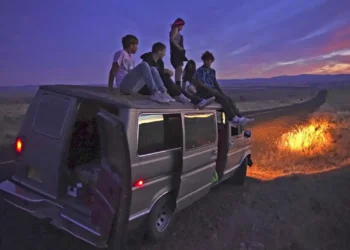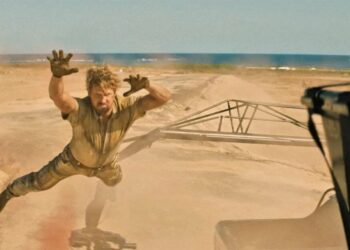Wes Anderson is a uniqueness, and we should be thankful he exists. But what is he? With each film, he’s doubled down on his particular battery of obsessive ideas (the chockablock dioramas, the loopy yarn-spinning, the deadpan quasi-farce, the overwhelming retro design), so that after a quarter-century of filmmaking, The French Dispatch (2021) was so intensely Wes-y, with more twitches and textual jokes than anyone could assimilate in one viewing, it felt almost like an experimental film. You have to salute his sui-generis-ness, his cultural curiosity, his subject-matter wanderlust, his distinctive visual craft, his attention to detail (often it feels like his films are all detail), and, honestly, his capacity for indexing some kind of late-Millennial/Gen Z toybox nostalgia, the hermetic pleasure of which, for his legion of devotees, should not be underestimated. If you fight in that pajama-clad army, you don’t ask questions, you just go. His newest confabulation, Asteroid City, is Wes-ness ascending — plastered with invention and pop-ironic formal beauty, and quirk-inhabited within an inch of its life.
Anderson has made hay of Manhattan, India, New England camping grounds, Japanese islands, and Alpine hotels; now he hits the southern American desert in the idealized ’50s, and with more than a whiff of Wile E. Coyote. The narrative is all set-up, and the set-up is characteristically arch: During the age of apparently ceaseless nuclear testing, a plethora of characters converge on the titular desert burg for the annual Junior Stargazer/Space Cadet convention, including a widowed war photog (Jason Schwartzman) and his “brainiac” son (Jake Ryan), plus three tiny triplet daughters, a famous actress (Scarlett Johansson) and her genius daughter (Grace Edwards), a fresh-faced teacher (Maya Hawke) with a precocious fifth-grade class in tow, a cowboy band (led by Rupert Friend), et cetera.
Already in Asteroid City are an administrative general (Jeffrey…
Read the full article here







